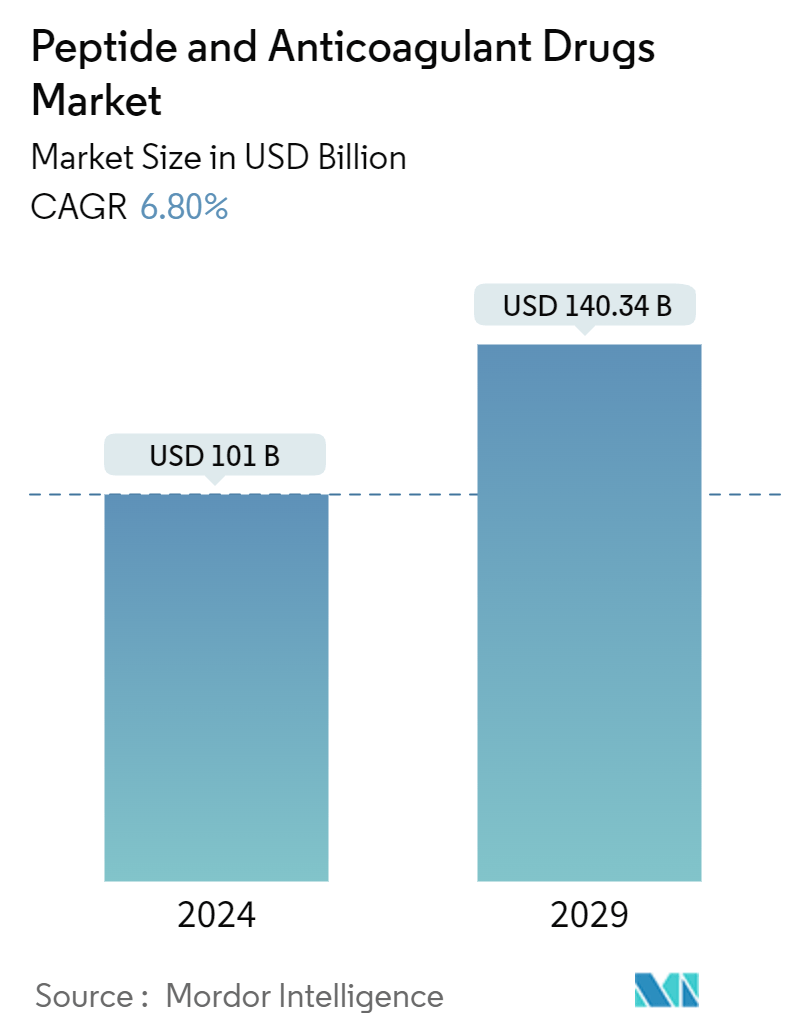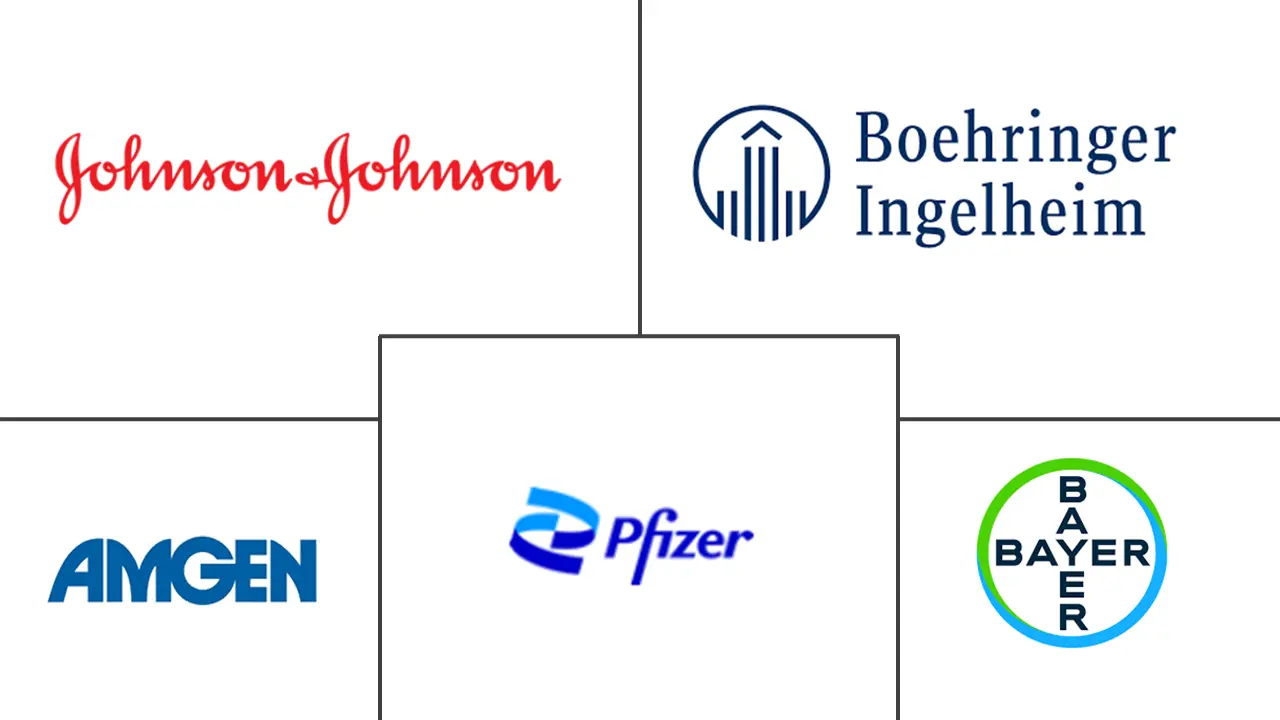Market Size of Peptide And Anticoagulant Drugs Industry

| Study Period | 2019 - 2029 |
| Market Size (2024) | USD 101 Billion |
| Market Size (2029) | USD 140.34 Billion |
| CAGR (2024 - 2029) | 6.80 % |
| Fastest Growing Market | Asia-Pacific |
| Largest Market | North America |
Major Players
*Disclaimer: Major Players sorted in no particular order |
Peptide And Anticoagulant Drugs Market Analysis
The Peptide And Anticoagulant Drugs Market size is estimated at USD 101 billion in 2024, and is expected to reach USD 140.34 billion by 2029, growing at a CAGR of 6.80% during the forecast period (2024-2029).
Various factors, such as the increasing prevalence of cancer and metabolic disorders, rising investments in the R&D of novel drugs, and technological advancements in drug development, are expected to enhance the market's growth.
The rising prevalence of cancer and other metabolic disorders is a significant factor driving the market's growth. For instance, according to the data updated by the Glocal Cancer Observatory (GLOBOCON) in February 2024, cancer cases were expected to rise from 4.82 million in 2022 to 5.72 million in 2030. Additionally, the prevalence of cancer is anticipated to reach 1.06 million in 2030, which is an increase from 1.01 million in 2022 in Japan. Thus, the greater prevalence of cancers has increased the demand for various peptide drugs to treat these diseases.
The rising R&D for novel drugs is also expected to boost market growth. For instance, according to the European Federation of Pharmaceutical Industries and Associations (EFPIA’s) Annual Report 2022, the research-based pharma industry invested USD 51.55 million (GBP 41.5 billion) in European research and development activities. Additionally, as per the report published in April 2022 by Biocon Biologics Limited, a subsidiary of biopharmaceutical market player Biocon, research and development expenses were increased by 187% to USD 106 million in 2023 (USD 37.2 million in 2022). Thus, the increase in research and development expenses is expected to promote the research activities for developing novel drugs, including peptide and anticoagulant drugs, driving the market growth.
The rising developments by major market players are also expected to enhance market growth. In November 2023, the American Heart Association reported that the investigational anti-clotting drug abelacimab effectively reduced bleeding among patients with atrial fibrillation. Additionally, in October 2022, Tiefeenbacher Pharmaceuticals launched the generic version of apixaban for an early market entry in Canada. Apixaban is an oral anticoagulant (blood thinner) indicated for preventing venous thromboembolism (VTE) in adult patients. Thus, such developments are expected to boost the adoption of peptide and anticoagulant drugs, contributing to market growth.
Thus, factors such as the increasing prevalence of cancer and metabolic disorders, rising investments in the R&D of novel drugs, and technological advancements in drug development are expected to enhance the market's growth. However, the high cost of developing medicines and stringent government regulations are expected to hinder this growth.
Peptide And Anticoagulant Drugs Industry Segmentation
Anticoagulants, commonly known as blood thinners, are used to block and treat blood clots in blood vessels and the heart, which can cause severe complications as the clot disrupts blood flow to essential organs and can result in heart attack and stroke. Peptides are long-chain amino acids held together by peptide bonds, also called amide bonds.
The peptide and anticoagulant drugs market is segmented by route of administration, application, and geography. The market is further segmented by route of administration into peptide and anticoagulant drugs. By peptide drugs, the market is sub-segmented into parenteral, oral, mucosal, and other routes of administration. With anticoagulant drugs, the market is sub-segmented into oral and injectable. The peptides drug segment is segmented into gastrointestinal disorders, cardiovascular disorders, neurological disorders, metabolic disorders, cancer, and other applications. The market is sub-segmented by anticoagulant drugs into atrial fibrillation and heart attack, stroke, deep vein thrombosis (DVT), pulmonary embolism (PE), and other applications. By geography, the market is segmented into North America, Europe, Asia-Pacific, the Middle East and Africa, and South America. For each segment, the market size is provided in terms of USD value.
| By Route of Administration | ||||||
| ||||||
|
| By Application | |||||||
| |||||||
|
| By Geography | ||||||||
| ||||||||
| ||||||||
| ||||||||
| ||||||||
|
Peptide And Anticoagulant Drugs Market Size Summary
The peptide and anticoagulant drugs market is poised for significant growth, driven by the increasing prevalence of cancer and metabolic disorders, alongside substantial investments in research and development of novel drugs. Technological advancements in drug development further bolster this growth trajectory. The rising incidence of cancer globally has heightened the demand for peptide drugs, as these are crucial in treating various cancer types. Concurrently, the pharmaceutical industry's focus on developing innovative drugs, supported by increased R&D expenditures, is expected to propel the market forward. Major developments by key players, such as the introduction of new anticoagulant drugs and advancements in drug formulations, are also contributing to the market's expansion.
North America is anticipated to maintain a substantial share of the market, driven by the high demand for peptide and anticoagulant drugs due to the rising prevalence of cancer and cardiovascular disorders in the region. The United States, in particular, is a significant contributor to this market share, with its growing burden of cancer and cardiovascular diseases. The competitive landscape is marked by the presence of major companies like Amgen Inc., Bayer AG, and Pfizer Inc., which are actively involved in developing and launching new drugs. These factors, combined with the ongoing advancements and regulatory approvals, are expected to sustain the market's growth momentum over the forecast period.
Peptide And Anticoagulant Drugs Market Size - Table of Contents
-
1. MARKET DYNAMICS
-
1.1 Market Overview
-
1.2 Market Drivers
-
1.2.1 Increasing Prevalence of Cancer and Metabolic Disorders
-
1.2.2 Rising Investments in R&D of Novel Drugs
-
1.2.3 Technological Advancements in Drug Development
-
-
1.3 Market Restraints
-
1.3.1 High Cost of Developing Drugs
-
1.3.2 Stringent Government Regulations
-
-
1.4 Porter's Five Forces Analysis
-
1.4.1 Threat of New Entrants
-
1.4.2 Bargaining Power of Buyers/Consumers
-
1.4.3 Bargaining Power of Suppliers
-
1.4.4 Threat of Substitute Products
-
1.4.5 Intensity of Competitive Rivalry
-
-
-
2. MARKET SEGMENTATION (Market Size by Value - USD)
-
2.1 By Route of Administration
-
2.1.1 Peptide Drugs
-
2.1.1.1 Parenteral
-
2.1.1.2 Oral
-
2.1.1.3 Mucosal
-
2.1.1.4 Other Routes of Administration
-
-
2.1.2 Anticoagulant Drugs
-
2.1.2.1 Oral
-
2.1.2.2 Injectable
-
-
-
2.2 By Application
-
2.2.1 Peptide Drugs
-
2.2.1.1 Gastrointestinal Disorders
-
2.2.1.2 Neurological Disorders
-
2.2.1.3 Metabolic Disorders
-
2.2.1.4 Cancer
-
2.2.1.5 Other Applications
-
-
2.2.2 Anticoagulant Drugs
-
2.2.2.1 Atrial Fibrillation and Heart Attack
-
2.2.2.2 Stroke
-
2.2.2.3 Deep Vein Thrombosis (DVT)
-
2.2.2.4 Pulmonary Embolism (PE)
-
2.2.2.5 Other Applications
-
-
-
2.3 By Geography
-
2.3.1 North America
-
2.3.1.1 United States
-
2.3.1.2 Canada
-
2.3.1.3 Mexico
-
-
2.3.2 Europe
-
2.3.2.1 Germany
-
2.3.2.2 United Kingdom
-
2.3.2.3 France
-
2.3.2.4 Italy
-
2.3.2.5 Spain
-
2.3.2.6 Rest of Europe
-
-
2.3.3 Asia-Pacific
-
2.3.3.1 China
-
2.3.3.2 Japan
-
2.3.3.3 India
-
2.3.3.4 Australia
-
2.3.3.5 South Korea
-
2.3.3.6 Rest of Asia-Pacific
-
-
2.3.4 Middle East and Africa
-
2.3.4.1 GCC
-
2.3.4.2 South Africa
-
2.3.4.3 Rest of Middle East and Africa
-
-
2.3.5 South America
-
2.3.5.1 Brazil
-
2.3.5.2 Argentina
-
2.3.5.3 Rest of South America
-
-
-
Peptide And Anticoagulant Drugs Market Size FAQs
How big is the Peptide And Anticoagulant Drugs Market?
The Peptide And Anticoagulant Drugs Market size is expected to reach USD 101 billion in 2024 and grow at a CAGR of 6.80% to reach USD 140.34 billion by 2029.
What is the current Peptide And Anticoagulant Drugs Market size?
In 2024, the Peptide And Anticoagulant Drugs Market size is expected to reach USD 101 billion.

